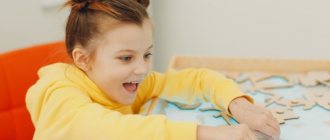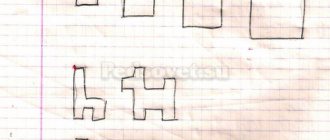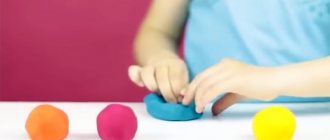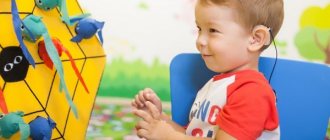Games to develop fine motor skills in children. As a child's fingers work, so does his brain. Teachers and educators know very well that speech deviations in 80 percent of children are a consequence of weak fine motor skills. To correct a child’s speech, you need to work on the mobility and fine motor skills of your fingers. Thanks to regular exercises, the hands and fingers will lose stiffness in their movements, and the brain will “wake up”, begin to absorb information, and speech activity will appear.
Development of motor skills in children with cerebral palsy
Cerebral palsy is a serious disease of the central nervous system. Often, a child has disturbances not only in motor activity, but also in speech. For these children, activities and games that awaken the nerve endings responsible for the activity of the hands and fingers are very important. You also need a massage that will strengthen the muscular system, increase tone, and help muscle contractility.
In this case, massage can be done:
- Toothbrush;
- Massage comb;
- Pencil, felt-tip pen;
- With balls, cereals;
- With walnuts.
Games with a massager
You can roll the massage ball from your fingertips to your elbow, between your palms and along the back of your hand.
Finger games
Harmonic
Exercise without speech accompaniment. Fingers converge and diverge.
Coil
Use your palm to roll a pencil, ball, or other objects.
"Nettle"
In our flowerbed, everyone is amazed (children pull the index finger of one hand with the thumb and index finger of the other hand)
A stinging nettle bush has grown (change hands and do the same with the index finger of the right hand)
To plant a rose (the exercise is repeated),
He must be defeated.
"Fire"
So that we can get fire (children rub palm against palm, repeat the quatrain)
Three palms against palms.
Suddenly your palm sparkles
And the piece of paper will light up (make different movements with your fingers).
Plasticine games
Children love to play with plasticine. You can crush and pinch, roll and press, cut, sculpt, and form figures.
Paper games
Wonderful material that can be torn and cut, wrinkled and folded. At the same time, naughty fingers begin to work. Imagination and attention also develop.
Unconventional drawing
It is difficult for a child with cerebral palsy to hold a brush with his fingers, but this should not prevent him from enjoying the creative process. You can take finger paints or chalk and the child can draw. You can also suggest drawing with crumpled paper, a sponge, or a cork. Such an unusual painting will interest a child.
Pyramids and nesting dolls
Playing with such toys is very useful for children with cerebral palsy. Putting on, taking off, putting in – these movements help develop fine motor skills of the hands. In addition, there is an awareness of the real size of the toy, familiarity with shapes and colors. Tactile sensitivity appears.
Motor development in children with Down syndrome
Down syndrome is not a disease, but a genetic condition. Children with Down syndrome often suffer from intellectual disabilities. At the same time, speech suffers and muscle tone is weak. Here it is necessary to apply a special technique, and to do it systematically.
We must remember that children with Down syndrome have the following characteristics:
- Instead of moving the hand, they often use the movement of the shoulder and forearm.
- It is easier for the child to fix the wrist in the desired position by placing the hand on a hard surface with the thumb up.
- Such children grasp an object in the following way: palm grip, pinch, tweezer grip and their intermediate forms.
Children with Down syndrome find it difficult to perform precise actions with small objects, so their hands need to be developed first.
With the help of special exercises, you can develop fine motor skills.
The simplest exercises: massage the palms and fingers, hands using brushes, soft and hard. Exercises on tearing paper, working with small objects, cereals, and sand will be interesting and useful. You can offer games of stringing beads, with fabric figures on buttons that need to be unfastened and fastened.
You will enjoy theatrical educational skits with aids made from figurines that are attached to the screen, wall, etc.
Ducks for a walk
- The game develops fantasy and imagination.
- The child begins to understand colors and shapes.
- He works with his hands.
- Assimilates values: kindness, help.
Figures of ducks are attached to the board. As the story progresses, new elements appear on the board: lake, sun, grass, rays, etc.
An adult turns to a child: “Look! Ducks came to visit us. They rush to the lake to swim. Say hello, what nice ducks! Where is the lake? Here it is. But the ducks wanted to nibble on the grass. Where's the weed? Here she is. (both the lake and the grass appear on Velcro and are attached to the board). The ducks took a swim. They need to dry out. Where is the sun? It has lost its rays! Let's help (rays are attached). The ducks are happy. They swam, ate and warmed up. What a great fellow you are!”
Magic buttons
- In this game, the fingers begin to work actively, at the same time the child learns to fantasize.
- Gains interesting work experience.
- Perseverance, patience, and attentiveness appear.
Again the adult turns to the child: “Winnie the Pooh is coming to visit!” But he doesn’t have the balls that he wanted to give to Piglet. Shall we help? Look how many buttons there are, let’s make a lot of balls out of them!” Ball buttons are laid out on a sheet where places are marked - contours for each button. The child must insert a button into a show jumper that is the right size and shape.
Other finger games, finger painting and plasticine modeling will also help. You can come up with interesting activities with paper. Make mosaics, applications, collages.
To strengthen the wrist, it is useful to use games with balls, massage and smooth ones. You need to teach your child to roll a ball. Playing with pyramids and screwing and unscrewing lids will help.
Water bombs
Playing with water will help develop fine motor skills. Plastic balls are thrown into a container of water and then caught with a net.
Medicine for the doll
In a glass of water you need to stir the gouache, which is thrown in a lump. The child must thoroughly stir the paint with a spoon.
Push coins into a piggy bank
Pushing small coins into a narrow hole is the best way to train motor skills. It is not as simple as it seems at first glance - to guide the coin so that it fits into a narrow hole.
I recommend setting aside a separate, clean piggy bank for your baby, and also washing a few coins in advance, so that you don’t have to wash your hands after each game with the piggy bank.
Theoretical aspects of conducting classes on the development of fine motor skills in preschool educational institutions
One of the problems caused by the deteriorating environmental situation on our planet has been the increase in the number of children with various speech development disorders. Currently, this figure has exceeded 50 percent, although at the end of the twentieth century. we were talking about only 17 percent. Therefore, both educators and parents should help the child overcome shortcomings in the formation of correct speech. An important part of this work is the use of exercises to develop fine motor skills. This type of task is used for pupils of all ages in the preschool education system, but has some differences in individual groups.
As the age of the preschooler increases, performing exercises requires the application of greater physical strength, the movements become more complex, and the details become smaller. This is aimed at improving finger dexterity, increasing accuracy and coordination of movements.
Sorting cereals is a most exciting activity for a baby
The origins of children's abilities and gifts are at their fingertips. From the fingers, figuratively speaking, come the finest threads-streams that feed the source of creative thought.
Author:
V. A. Sukhomlinsky
Forming and improving fine motor skills of a child’s fingers complicates the structure of the brain, develops the psyche, speech and intellectual abilities, and contributes to the development of the preschooler’s personality. This is the main goal of classes in kindergarten.
Lesson objectives
- Developing the child’s ability to make precise movements with the hand and fingers.
- Development of tactile sensitivity of hands.
- Formation of the ability to coordinate the work of hands with visual perception.
- Development of speech, improvement of pronunciation of sounds.
- Development of thinking, imagination, spatial orientation, memory, attention.
- Mastering vital skills and everyday skills.
- Preparing your hand for writing.
- Development of the ability to create crafts from various types of materials (plasticine, paper, cereals, buttons, etc.).
- Relieving psycho-emotional stress.
Finger painting develops tactile sensitivity
Simple hand movements help relieve tension not only from the hands themselves, but also from the lips.
Table: techniques used to develop motor skills of different age groups
| Group | Techniques |
| First youngest |
|
| Second youngest |
|
| Average |
|
| Older |
|
| Preparatory |
|
Types of development of a child’s fine motor skills
There are several types of psychophysical development of a preschooler:
- Visual-motor coordination provides visual perception of moving objects and correlates it with body movement, it determines the movement of the child’s hand while writing or drawing, the ability to find the optimal way to complete a graphic task, and provides tactile sensitivity.
- Graphomotor development allows you to correctly hold a pen or pencil, determines the position of the writing hand, includes spatial orientation, including on a sheet of paper, and a sense of rhythm.
- Psychomotor (motor) development includes the development of not only fine, but also gross motor skills. Moreover, gross motor skills are considered basic; without its sufficient development, the child will not be able to correctly practice fine movements.
To master the skill of writing, it is important that the child holds the pen correctly.
The system of classes for the development of fine motor skills in a preschool institution takes into account the characteristics of all types of child development. Daily classes include exercises aimed at solving this problem. Teachers also involve parents in their work, because fine movements need to be practiced with children constantly: during games, doing simple chores around the house, dressing and undressing on their own.
Diagnosis of the development of fine motor skills in kindergarten
To properly plan work, the teacher must diagnose the development of fine motor skills of preschool children. Diagnosis is carried out according to the following criteria:
- Static loads on the muscles of the hand. Exercises are performed in which the child must hold his fingers in a certain position while counting to 10.
- Dynamic loads. Tasks are given with scissors and to tear off paper evenly (the coordinated work of both hands is checked).
- Tactile sensations. A preschooler should be able to determine by feeling the shape of an object and the material from which it is made: metal, glass, plastic, wood.
- The amount of muscle tone in the hands. An exercise to squeeze an object with two or one hand; you can squeeze the teacher’s palm.
- Ability to coordinate hand movements. Threading a thread into the eye of a needle, an exercise for quickly changing two static positions of the hand (fist - edge).
- Hand pinch work. It analyzes how the child holds the pen, in which hand, when writing; Is it possible to rub a lump of salt with your fingertips?
To correctly determine the level of development of a child, it is important to carry out diagnostics in a comfortable environment for children.
All diagnostic exercises are performed by children after demonstration by the teacher. It is advisable to record information in a relaxed atmosphere, creating game situations.
Video: diagnostics of fine motor skills of children 4–5 years old
The development of fine motor skills begins in the first months of life. The child strives to touch, move, and even taste each new object. These actions are inherent in nature itself. Adults only need to help the little person get more information from the world around him, teach him to move correctly, develop speech, and cultivate character. After all, the intellectual and creative development of the individual depends on this. Both parents and educators must do everything necessary so that the child can reach his full potential and become a successful person in the future.
Classes for the development of fine motor skills in preschool educational institutions
As a rule, the teacher includes certain exercises to develop fine motor skills in daily classes with children. But you can conduct a full-fledged lesson focused on achieving this goal. Like any lesson with preschoolers in kindergarten, it consists of 3 parts:
- Introductory part: it includes exercises for warming up the fingers and hands; This is where the plot of the lesson is established and techniques are used to increase children’s interest in participating in the lesson.
- Main part: using the development of the plot, exercises are included that correspond to the assigned tasks.
- The final part: the lesson is summed up and relaxation is carried out.
For more information on how to create a plan for the development of fine motor skills, read our article - How to create a self-education plan on the topic “Development of fine motor skills in preschoolers.”
The lesson can be devoted to modeling from kinetic sand or salt dough
Table: example of a note on the development of fine motor skills in the second junior group
| Author | Goncharova I. F., teacher of MK preschool educational institution Pavlovsk kindergarten No. 5, Pavlovsk |
| Subject | "Finger games with Lisa" |
| Target | Work with children on various techniques and activities to develop fine motor skills. |
| Tasks |
|
| Introductory part | V.: Hello, guys! Interesting tasks await us today, and our assistants will help us complete them. You will find out who they are by guessing the riddle.
V.: That's right, these assistants are our fingers. Our fingers are friendly and obedient. Let's show how they know how to say hello.
V.: There are five fingers on each hand. Although they are similar, each finger has its own name. Let's remember the names of our fingers.
V.: Our fingers are our magical helpers. They must work hard. Let's wake them up before we get to work.
|
| Main part | Someone is knocking on the group's door. The teacher draws the children's attention to a knock on the door. V.: Listen, someone came to us. Who is this? (The teacher brings in a large doll.) This is our friend - the Lisa doll. Hello, Lisa! (Children say hello to Lisa). Guys, Lisa brought a magic chest with her.
V.: Well, let's try to open the chest. (Tries to lift the lid, but fails).
V.: To begin with, Lisa prepared a task for us. (The teacher places in front of the children a “dry pool” filled with chestnuts.) Now our fingers will turn into magical gnomes and help us find the “treasures” that Lisa hid. (Children take out clothespins from the “dry pool”). What are these clothespins for? Listen to the first riddle:
The teacher takes out a paper blank of fish without fins and tail. Q: Guys, what is our fish missing? Let's fix it with the clothespins we found. (Children attach clothespins to the fins and tail). Well done! Listen to the second riddle.
V.: We solved all of Lisa’s riddles. (Tries to open the chest again, but fails.)
The teacher puts the sun on the easel. Q: Guys, why has it become so light and warm? What does the sun look like? Can you say it looks like a flower? How? What is it like, sunshine? If you were drawing a sun, where would you start? After we draw a circle, what should we draw? Look, I have sunshine, but you don’t have it yet. Now our fingers will turn into magic pencils, and each of you will draw the sun for yourself, and then our place will be even brighter and warmer. (Children approach the trays with semolina and draw the sun on the cereal with their fingers). V.: Our fingers can also draw in the air.
The teacher opens the chest and finds candy in it. |
| Final part | V.: Guys, you are all great! You completed all of Liza’s tasks, she really enjoyed visiting you! And our magical assistants - our fingers - helped us complete all the tasks. They must work hard to help the tongue learn to speak well. And now it’s time for Lisa to go home! She says goodbye to us. Let's tell her goodbye!
|
| Quote from: https://infourok.ru/zanyatie-po-razvitiyu-melkoy-motoriki-vo-vtoroy-mladshey-gruppe-1520776.html | |
Table: example of a summary of a correctional and developmental lesson in a preparatory group
| Author | Khalilova S. A., teacher-defectologist MBOU "Dobrovskaya school-gymnasium named after Ya. M. Slonimsky", Simferopol district, Republic of Crimea. |
| Subject | “Development of fine motor skills, writing skills, articulatory motor skills” |
| Goals |
|
| Tasks |
|
| Introductory part | Psychological mood.
Report the topic of the lesson. Mystery:
Defectologist: What can our fingers do? (Hold a pencil, draw beautifully, write, build from a construction set, sculpt from clay and plasticine, sew, embroider...). Our fingers can do anything, which means they are magical! Fingers don't become skilled right away. We will help you to be skillful with your fingers, we will do exercises that will help you learn to write and draw beautifully. Warm-up (exercise) for hands (self-massage).
Exercise "Saw". Purpose: to teach hand warm-up skills. It has a general strengthening effect on the muscular system, increases tone, elasticity and contractility of muscles. The left hand lies on the table with the palm up, with the edge of the right palm we imitate sawing over the entire surface of the left hand in the up and down direction. Same for the other hand. You can do the same for the back of your hand.
Exercise “Spin, pencil.” Goal: learn to roll a pencil (or tube) on the table, first with one hand, and then with the other. Exercises with fingers. Using circular movements of the thumb and index finger, knead each finger, starting from their tips:
|
| Main part | Exercise “One piggy bank, two piggy banks.” You will need a glass jar or other transparent container. We cut small rectangular holes in the lid (one large one for larger items, another smaller one for smaller items). We prepare multi-colored buttons of different diameters. We invite the child to place buttons in containers, as if in a piggy bank. You can then count the number of large and small buttons. Buttons can be replaced with coins. Finger gymnastics “Birds” (relaxation of arm muscles).
Drawing lines:
|
| Final part | Exercise “Magic Glasses” (developing empathy for each other, increasing self-esteem, M. V. Kiseleva). Defectologist: I want to show you magic glasses. The one who puts them on will see only the good in others, and even the good that a person sometimes hides from everyone. Now I’m going to try on these glasses... Oh, how beautiful, funny, smart you all are! Approaching each student, the defectologist names everything in which the child was successful in class today. |
| Quote from: https://infourok.ru/konspekt-korrekcionnorazvivayuschego-zanyatiya-razvitie-melkoy-motoriki-navikov-pisma-artikulyatornoy-motoriki-997094.html | |
Games to develop fine motor skills in kindergarten
Play is the main activity in the life of a preschooler. Through play, he gets acquainted with the world around him, his psyche is formed, personality formation and physical development occur. Exercises to improve fine motor skills often involve repeating small finger movements. The child will quickly get tired of doing such work if it is not presented in the form of a game. Playing activities improves mood, develops imagination and fantasy, joint games with peers awaken a sense of collectivism, and games with the participation of relatives unite the family. In kindergarten, exercises to develop fine motor skills can be combined with warm-up activities.
For older preschoolers, you can include shadow theater performances in your classes.
Such games with clothespins not only develop fine motor skills, but also reinforce color knowledge
Table: card index of games for the development of fine motor skills in preschool educational institutions
| Type of game | Examples of didactic developments |
| Finger gymnastics with poems and nursery rhymes |
|
| Finger games (gymnastics for hands) |
|
| Games to develop tactile sensations |
|
| Self-massage of hands with a soft ball, cones, nuts, pencils |
|
| Lacing, unscrewing covers, bolts |
|
| Games with clothespins, paper clips, threads, buttons |
|
| Creative work, playing with paper, drawing |
|
Photo gallery: examples of games for developing fine motor skills
The finger game “Two Bears” is also aimed at memorizing body parts
Preschoolers enjoy performing the exercise “Chizhik-fawn”
The game "Tsar's Court" requires good coordination of movements.
The game "Bunny and the Hedgehog" is suitable for the youngest pupils
Photo gallery: shadow theater
With the help of shadow theater you can show various animals
These figures are not as easy to execute as they seem
The child must remember a certain position of the hands to obtain the appropriate image










